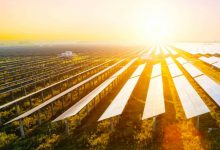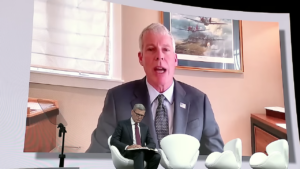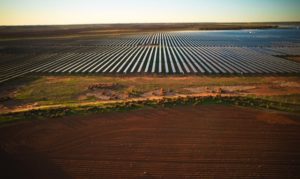Australia will need at least 30GW of new wind and solar capacity to replace expected coal generator retirements over the next two decades, and could require up to 47GW of new capacity in the case of a “step change” scenario that takes serious action on climate change into account.
Those are the headline numbers from the draft Integrated System Plan unveiled on Thursday by the Australian Energy Market Operator – its effort to update its 20-year blueprint on how Australia’s grid could and should be managed under a range of different transition scenarios.
These scenarios range from “slow change” – which is consistent of a world controlled by fossil fuel interests and delivers a catastrophic rise in average temperatures – all the way through to “step change”, a new scenario developed by AEMO to consider what must be done to respect the scientific experts and try to keep average global warming as close as possible to 1.5°C.
In this scenario, AEMO outlines a plan to reach around 90 per cent renewables by 2040. The bulk of this generation comes from large-scale wind and solar, supported by distributed (mostly rooftop) solar, along with hydro power, and “dispatchable” technologies such as pumped hydro, big batteries, and household batteries aggregated in “virtual power plants”.
In this scenario, black and brown coal are virtually eliminated from the grid, and gas is also priced out by cheaper and more efficient storage technologies. At least 30GW of new wind and solar will be needed, and up to 47GW, and significant amounts of dispatchable capacity.
Whatever the scenario, the key message from AEMO’s Alex Wonhas, who led the development of the ISP, is that urgent action is needed.
At least two thirds of coal generators will be gone by 2040, and Australia has fallen behind in its build out of network infrastructure and updating its market rules and regulations to facilitate the technologies that replace them. As AEMO boss Audrey Zibelman said earlier this week: “We can’t wait anymore.”
The draft ISP – which expands on the first version delivered late last year, and which won’t be finalised until the middle of 2020 – identifies a series of urgent action that is needed to accommodate the inevitable switch to wind, solar and storage, even if the pace of that transition differs in varying scenarios.
Apart from the need to build more generation capacity to replace the retiring coal generators, AEMO says the national grid will between 5GW and 21GW of new “dispatchable” generation by 2040 – and this includes battery storage, both at grid level and in households, as well as pumped hydro projects, fast-starting gas generators, and “demand side” technologies.
“The Draft 2020 ISP sets out how to build a least-cost system for Australia, but for consumers to receive the full benefit of the plan, important additional work on market design and infrastructure funding options needs to be undertaken,” Zibelman said in a statement accompanying the report.
“At the direction of state and federal ministers, the Energy Security Board is undertaking this work and AEMO looks forward to supporting it.”
The Group 1, or priority projects, are considered critical to address cost, security and reliability issues and should be either underway or commencing soon. They are also key to ensuring that the areas with the lowest cost wind and solar resources are accessed.
They include: a new interconnector from South Australia to Wagga Wagga in NSW, an upgrade to the links from Queensland to NSW, and from Victoria, and a new interconnection from Tumut to Bannaby to reinforce the southern NSW grid.
In addition, AEMO is recommending planning and approvals work be commenced now for a new transmission link from Tasmania to Victoria (Marinus Link for the so-called “battery of the nation”), to ensure it could commence construction by 2023 should that be required, most likely if there is a delay to Snowy 2.0 or a Victoria coal generator closes earlier than anticipated.
The draft ISP warns, however, that the transition, at whichever speed, will not be without issues, and needs to be both flexible and transparent.
“The complexities include the rapid introduction of increasing levels of consumer-driven DER, satisfying the critical operational needs for the power system, arrangements to replace exiting generators and deploy replacement resources ahead of, or in alignment with, those exits, low-cost but variable resources, storage, transmission investments, climate change impacts, and increasingly scarce system services.”
 “The second major complexity for the Draft ISP is forecasting when existing black and brown coal plants will either reduce generation or shut down.
“The second major complexity for the Draft ISP is forecasting when existing black and brown coal plants will either reduce generation or shut down.
“The owners of these assets will make their decisions based on a range of commercial factors, and in the context of energy and climate change policies, market arrangements, competing technologies, and social and investor licences. The Draft ISP’sobjective is to maintain power system reliability and security throughout this transition.”
AEMO says the Draft ISP assumes generation investments will be guided by a well-functioning market that has appropriate signals to guide timely investments.
That in turn leads to another challenge – ensuring that the rewrite of the market design contemplated by the Energy Security Board, in tandem with the likes of the AEMC, and with the fossil fuel lobby and their pawns throwing stones at the windows – delivers what it is supposed to do – a market fit for purpose for modern technologies and which finally takes the environment into account.
As Zibelman flagged earlier this week, the amount of rooftop solar is likely to double, or even treble, over the next 20 years as households lead the “democratization” of energy and the shift from a centralized to a distributed model. This require changes that add visibility and “controls” to the way these assets function.
Household solar is likely to provide one quarter of the electricity supply by 2040, but other distributed resources such as batteries, demand management, electric vehicles will also play a critical role, sometimes aggregated through virtual power plants.
 The difference in scenarios is illustrated in this chart (click on it to expand).
The difference in scenarios is illustrated in this chart (click on it to expand).
The 90 per cent renewables share delivered under the step change scenario may come as a shock to climate science and technology deniers within the Coalition and the right wing commentariat.
But there are signs that the Coalition hierarchy is starting to grasp the shift in energy economics, even if they continue to ignore the environment.
The recent emissions reduction path mapped out by minister Angus Taylor assumes Australia will reach 50 per cent renewables by 2030, despite his previous warnings of the economic catastrophe that would entail.
It turns out that these are the only actual emissions reductions achieved over the next 10 years. Assuming this forecast is right, then the miserable “slow change” scenario modeled by AEMO can be readily discarded.
The central model assumes no change to current state and federal policies, while the other two scenarios are driven by technological change and consumer pull (an even greater take-up of rooftop solar).
See also: Which parts of Australia deliver the cheapest wind and solar?











